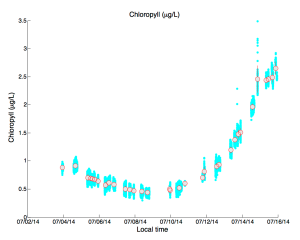I have the privilege of writing the very first blog for our major 2014 NSF Center for Aerosol Impacts on Climate and the Environment (CAICE) summer intensive named IMPACTS (Investigation into Marine PArticle Chemistry and Transfer Science). Things have been incredibly busy with many people working long days (phytoplankton don’t sleep!). We are now at the mid-point in the study. We have about 40 students, ranging from high school through graduate school, and postdoctoral fellows working on this project. They came from many places with their unique instrumentation to work with us at UCSD/SIO including U. of Iowa, U. of Wisconsin, Colorado State University, UC Davis, UC Berkeley, Colby College, and Rwanda via Cal Baptist College. It is an exciting but very challenging experiment where we are setting out to produce the world’s largest indoor phytoplankton bloom in 3000 gallons of seawater in a 33 m wave flume equipped with real breaking waves. Phytoplankton are tiny microscopic plants (just think of the ocean as an underwater forest) that fix carbon from the atmosphere and produce almost 50% of the oxygen we breathe. Chlorophyll is an indicator of the quantity of phytoplankton that is present. When a bloom occurs, scientists can watch chlorophyll change from space using satellite imagery.

Red tide phytoplankton bloom off the Scripps Pier at UC San Diego
The image on the left shows what a phytoplankton bloom (called a red tide) looks like off the Scripps Institution of Oceanography pier. When these blooms occur, they can cover large regions of the ocean and dramatically change ocean chemistry. The ultimate goal of our study is to investigate the transfer of chemical and biological species from seawater into sea spray aerosols and measure how this chemistry evolves over the course of a phytoplankton bloom. Over the past 2 years, we have found we can reproducibly induce phytoplankton blooms in much smaller tanks. It turns out it is much more challenging in a wave flume! This is due to the fact that the tank is filled with a myriad of species (bacteria, phytoplankton, viruses) all competing for nutrients (i.e. food) we initially put in the tank. Another major challenge is the large “grazers” that are like little Pacmen that go around and consume the phytoplankton before they can grow into a bloom. Once we get a bloom and sea spray is emitted, we measure the ability of the particles to undergo chemical reactions, induce ice cloud formation, form cloud droplets, as well as interact with sunlight. The grand challenge involves understanding how the chemical complexity of the seawater changes and how this impacts climate and reactivity properties of the sea spray. The premise for CAICE is to perform the next generation of lab studies where we learn about the real world by bringing its true complexity into the lab where we can control many of the parameters at a level that cannot be done in the field. I believe this has to be one of the most challenging experiments ever done in a laboratory setting due to how difficult it is to rely on the complexity of biological processes to naturally evolve under lab conditions (less light, changing temperatures, etc.)….the good news is I think we have finally done it!

IMPACTS-2014: graph showing growth of phytoplankton over time as indicated by chlorophyll-a concentrations in CAICE ocean-atmosphere wave flume in July 2014. This represents the world’s largest indoor ocean phytoplankton bloom in natural seawater equipped with breaking waves
After waiting nervously for almost 2 weeks of “background” measurements, the bloom started taking off on July 10 and it has been growing since then. We know this by monitoring chlorophyll levels which have been increasing over time. We are all very excited that we are finally getting to measure what we set out to measure. That is not always the case in complex “field studies” and certainly not the case just because this one is in the lab. Now chemists are positioned to directly measure the chemical composition and physical properties of complex sea spray aerosol in ways that have never been done before. This was made possible by a devoted team that has been brought together through CAICE. Finally on a personal note, I will say that the last month has been one of the most challenging ones I have faced as a professor; yet, it has been the most rewarding research experience I have ever been involved in. I have so enjoyed the day-to-day interactions with this team of young scientists and getting the opportunity to work in the trenches with them to help make a difficult experiment take off. Their drive and positive can-do attitudes make it clear to me that the next generation of scientists is well equipped to tackle the complex environmental problems that we will be facing. In subsequent blogs, you will get to hear from other CAICE scientists about their experiences and measurements and how they are trying to address the questions above. I hope you enjoy following the CAICE IMPACTS-2014 blog over the next couple of weeks.
Kimberly A. Prather, Director of CAICE (http://caice.ucsd.edu)

